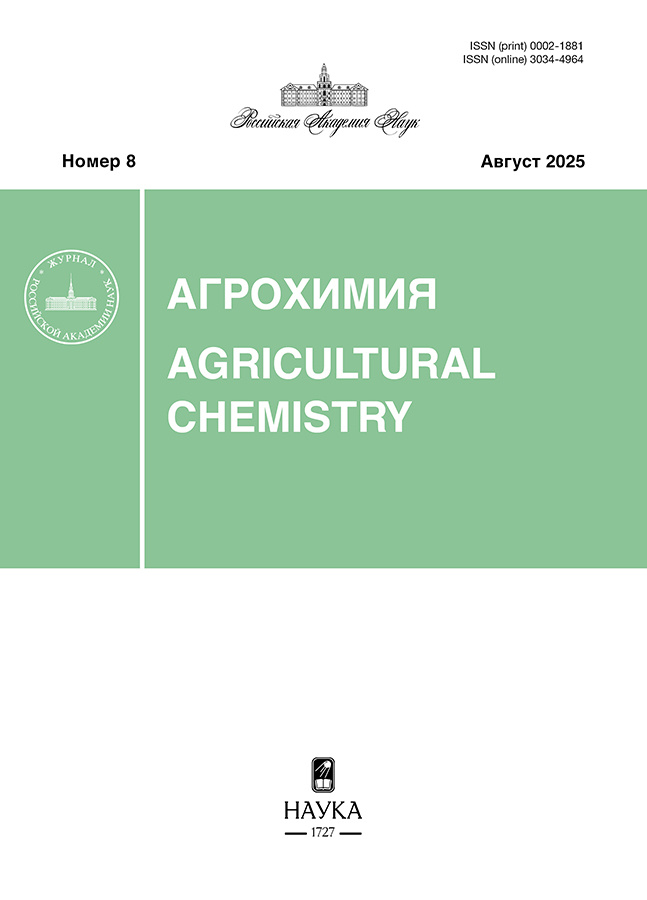Prolonged influence of growth stimulators
- Authors: Ostroshenko V.Y.1
-
Affiliations:
- Federal Scientific Center for Biodiversity of Terrestrial Biota of East Asia, Far Eastern Branch of the RAS
- Issue: No 8 (2025)
- Pages: 56-61
- Section: Plant growth regulators
- URL: https://rjeid.com/0002-1881/article/view/691205
- DOI: https://doi.org/10.31857/S0002188125080073
- EDN: https://elibrary.ru/stkupi
- ID: 691205
Cite item
Abstract
Korean cedar (Pinus koraiensis Siebold et Zucc.) is used to create artificial plantings in the landscaping process, in construction and medicine. However, due to forest fires and logging, the area and reserves of cedar are limited. As a result, it is necessary to take measures to restore it. This is possible through the use of growth stimulants. The prolonged effect of the growth stimulant Zircon together with the preparations Koren Super and HB-101 on the growth of 3-year-old Korean cedar seedlings was studied. Cedar seeds harvested on the territory of s. Kamenushka of Primorsky Krai were sown three times in a forest nursery on the territory of the Komarov Mountain Taiga Station, a branch of the Federal Research Center for Biodiversity of the Far Eastern Branch of the Russian Academy of Sciences. After the onset of seedlings and after the next 2 weeks in the 1st year of growth, seedlings were fertilized with a Zircon stimulant with a solution concentration of 1 ml/10 liters of water. In the 2nd year of growth, the seedlings were treated with HB-101 stimulants (concentrations of 10 drops/5 l and 10 drops/10 L solutions) and Super Root (concentrations of 5 g/5 l and 5 g/10 l). The control was seedlings not treated with growth stimulants. It was revealed that the morphometric parameters of 3-year-old Korean cedar seedlings were more positively affected by the option of root top dressing with the Zircon stimulant together with the HB-101 preparation in a solution concentration of 0.5 ml/5 liters of water. The excess of the control height of seedlings was 19.3%, the diameter of the stem at the root neck was 33.3%, the length of the roots was 3%, and the increase in total dry weight was 91.1%. A significant effect on the increase in the mass of the aboveground part of seedlings, especially needles, was noted. The 3-year-old seedlings grown in the nursery can later be used for landscaping after growing in the nursery school department.
About the authors
V. Yu. Ostroshenko
Federal Scientific Center for Biodiversity of Terrestrial Biota of East Asia, Far Eastern Branch of the RAS
Email: OstroshenkoV@mail.ru
prosp. 100-letiya Vladivostoku 159, Vladivostok 690022, Russia
References
- Острошенко В.Ю. Влияние стимуляторов роста на биометрические показатели четырехлетних саженцев пихты почкочешуйной (белокорой) (Abies nephrolepis (Trautv.) Maxim.) // Аграрн. наука. 2023. № 374 (9). С. 110–115. doi: 10.32634/0869-8155-2023-374-9-110-115
- URL: https://primorsky.ru/upload/medialibrary/3a4/m0tt9bprc1sust2pue2f6mad 1g56n3wr.pdf.
- Парфенова Е.Д. Динамика кедрово-широколиственных лесов Дальнего Востока // Сб. докл. Международ. научн.-практ. конф. “Современные технологии воспроизводства экологической среды на урбанизированных территориях”. Хабаровск, 2020. Вып. 5. С. 80–82.
- Никитенко Е.А. О возможности искусственного восстановления кедра корейского в Хасанском районе Приморского края // Изв. СПб. лесотехн. акад. 2018. № 225. С. 120–130.
- Острошенко В.Ю. Пролонгированное влияние корневой подкормки стимуляторами роста одно-двулетних саженцев кедра корейского (Pinus koraiensis Siebold et Zucc.) на их биометрические показатели в 8-летнем возрасте. 2023. Вып. 71. С. 146–153.
- Острошенко В.Ю., Шеин М.Н., Острошенко Л.Ю. Пролонгированное влияние стимуляторов на рост трехлетних сеянцев кедра корейского (Pinus koraiensis Siebold et Zucc.) // Аграрн. наука. 2023. № 377(12). С. 118–123.
- Долгополова Н.В., Бабаскина А.А. Влияние стимуляторов роста на развитие и продуктивность озимой пшеницы // Вестн. Курск. ГСХА. 2022. № 1. С. 34–41.
- Иванова М.С. Применение стимуляторов роста при предпосевной обработке семян //Аграрн. образ-е и наука. 2022. № 4. С. 6.
- Ситало Г.М., Бельтюков Л.П., Гордеева Ю.В. Рост, развитие и формирование урожайности гороха под влиянием биопрепаратов и стимуляторов роста // Политемат. сетев. электр. научн. журн. Кубан. ГАУ. 2021. № 165. С. 186–195.
- Бакшеева Е.А. Способы подготовки семян хвойных пород к посеву // Научн. тр. студентов Ижевск. ГСХА. 2022. № 1. С. 370–373.
- Кулькова А.В., Бессчетнова Н.Н. Грунтовая всхожесть семян ели Шренка при интродукции в Нижегородскую область // Актуал. пробл. лесн. комплекса. 2020. № 58. С. 97–100.
- Острошенко В.Ю., Острошенко Л.Ю. Влияние стимулятора роста Экопин на посевные качества семян и морфометрические показатели проростков пихты почкочешуйной (белокорой) (Abies nephrolepis (Trautv.) Maxim.) // Агрохимия. 2021. № 10. С. 11–16.
- Острошенко В.Ю., Острошенко Л.Ю., Полещук В.А. Влияние стимулятора роста Крезацин на прорастание семян пихты цельнолистной (Abies holophylla Maxim.) // Агрохимия. 2022. № 3. С. 47–51. doi: 10.31857/S0002188122030085
- Резвякова С.В., Гурин А.Г., Резвякова Е.С. Размножение хвойных пород зелеными черенками с использованием новых биопрепаратов // Вестн. Орлов. ГАУ. 2017. № 2. С. 9–14. doi: 10.15217/48484.
- Салцевич Ю.В., Буряк Л.В., Агеев А.А. Динамика роста опытных лесных культур ели сибирской // Реализация Стратегии развития лесного комплекса РФ до 2030 года в новых реалиях. Мат-лы Всерос. научн.-практ. конф. Иркутск: Изд. дом БГУ, 2023. С. 127–134.
- Устинова Т.С. Влияние биостимулятора НВ-101 на рост сеянцев сосны обыкновенной // Мат-лы Международ. научн.-практ. конф. “Актуальные проблемы развития лесного комплекса и ландшафтной архитектуры”. Брянск, 2016. С. 316–321.
- Brent A.C., Bert M.C. Gibberellic acid inhibitors control height growth and cone production in Abies fraseri // Scand. J. Forest Res. 2017. V. 32. № 5. Р. 391–396. doi: 10.1080/02827581.2016.1242771
- Shchukin R.A., Bogdanov O.E., Zavoloka I.P., Ryazanov G.S., Kruglov N.M. Biotechnological basis for application of growth regulators for rooting of green cuttings of trees and shrubs in a greenhouse with a misting system // BIO Web of Conf. 2020. V. 23. № 01009. doi: 10.1051/bioconf/20202301009
- Усова К.А., Белопухов С.Л., Шайхиев И.Г. Экологически безопасные высокоэффективные регуляторы роста растений для цветочнодекоративных культур (обзор российской литературы) // Вестн. технол. Казан. ун-та. 2016. Т. 19. № 21. С.193–198.
Supplementary files










